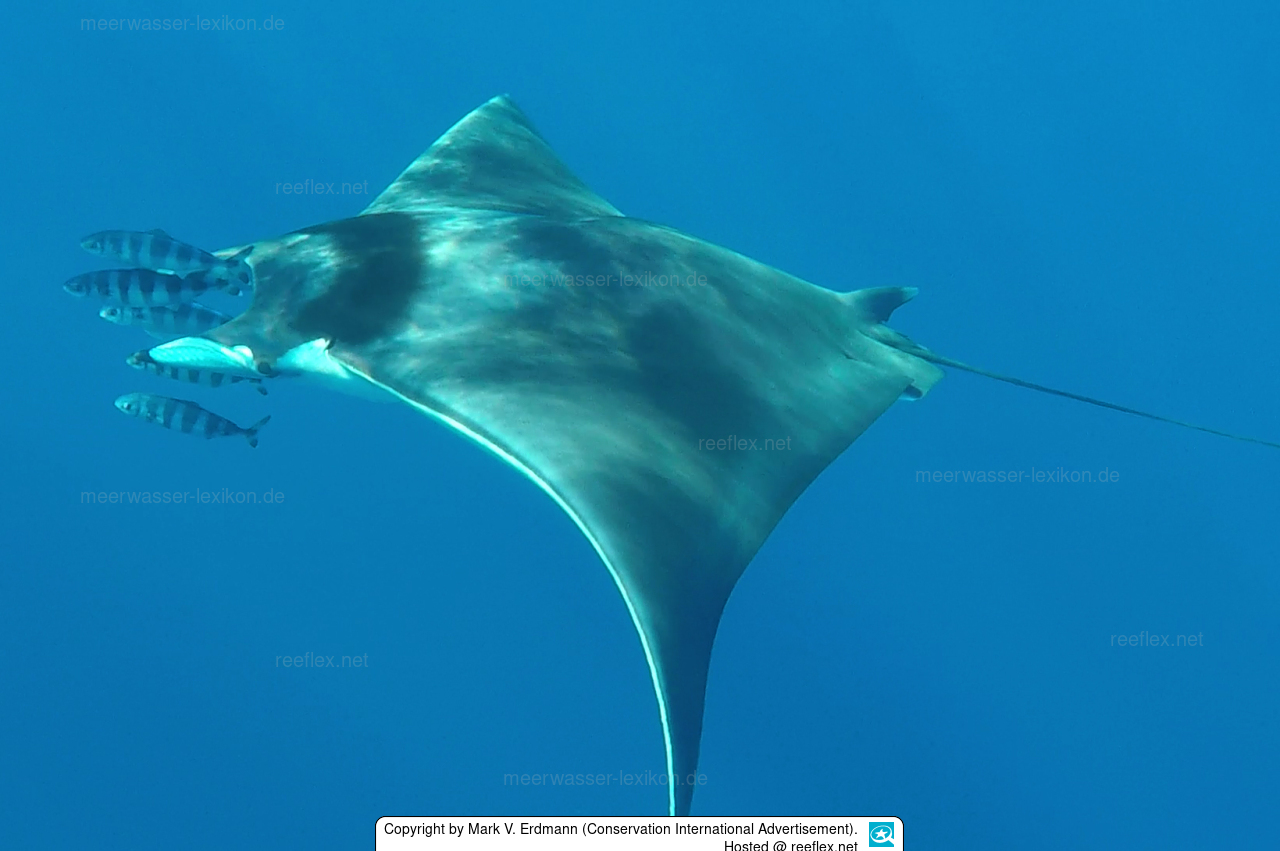Info
Mobula mobular (Bonnaterre, 1788)
Mobula mobular is a very large, bluish-black devil ray with two white, crescent-shaped spots on the shoulders that appear in juveniles and neonates (which fade in adults), a white underside, often with dark spots, and a prominent white tip on the dorsal fin and a dark inner surface of the mouth.
The fin-like lobes are short with black tips, showing a silvery gray inner surface and a white outer surface behind the eye.
The devil ray has a subterminal mouth below the head, a small dorsal fin with a white tip, and a short, serrated caudal spine located near the base of the very long whip-like tail.
The data on the size of vary, depending on the source, between 520cm and 650cm, it is quite conceivable that one of the English names of Mobula mobular, Japanese devil ray, with the ray Mobula japanica, may have led to confusion and misattribution of data.
This also applies to the depth distribution of the ray, which is said to range from 0 - 700 meters to 0 - 1112 meters (Fishes of Australia).
In any case, the water depth of 1112 meters is documented for Mobula japanica.
It is also unclear whether the tip of the stingray's spine is poisonous or non-toxic, scientific documentation can be found on the web for both statements.
Rays, like other marine animals, are among the victims of plastic pollution in the sea, because they can not distinguish between small pieces of plastic and small plankton and then eat it.
Synonymised names
Aodon cornu Lacepède, 1798 · unaccepted
Aodon japonicus (Müller & Henle, 1841) · unaccepted > junior subjective synonym (also misspelling of the...)
Apterurus fabroni Rafinesque, 1810 · unaccepted
Cephaloptera giorna (Lacepède, 1803) · unaccepted
Cephaloptera japanica Müller & Henle, 1841 · unaccepted
Cephaloptera tatraniana van Hasselt, 1823 · unaccepted
Cephalopterus edentula Griffini, 1903 · unaccepted
Cephalopterus giornae (Lacepède, 1803) · unaccepted
Cephalopterus massena Risso, 1810 · unaccepted
Dicerobatis giornae (Lacepède, 1803) · unaccepted
Manta mobular (Bonnaterre, 1788) · unaccepted
Mobula auriculata Rafinesque, 1810 · unaccepted
Mobula diabolus (Shaw, 1804) · unaccepted (ambiguous synonym)
Mobula japanica (Müller & Henle, 1841) · unaccepted > junior subjective synonym
Mobula japonica (Müller & Henle, 1841) · unaccepted (misspelling)
Mobula rancureli Cadenat, 1959 · unaccepted
Mobular mobular (Bonnaterre, 1788) · unaccepted > misspelling - incorrect subsequent spelling
Raia fabroniana Lacepède, 1800 · unaccepted
Raia mobular Bonnaterre, 1788 · unaccepted
Raja cephaloptera Bloch & Schneider, 1801 · unaccepted
Raja diabolus Shaw, 1804 · unaccepted
Raja giorna Lacepède, 1803 · unaccepted
Squalus edentulus Brünnich, 1768 · unaccepted
Mobula mobular is a very large, bluish-black devil ray with two white, crescent-shaped spots on the shoulders that appear in juveniles and neonates (which fade in adults), a white underside, often with dark spots, and a prominent white tip on the dorsal fin and a dark inner surface of the mouth.
The fin-like lobes are short with black tips, showing a silvery gray inner surface and a white outer surface behind the eye.
The devil ray has a subterminal mouth below the head, a small dorsal fin with a white tip, and a short, serrated caudal spine located near the base of the very long whip-like tail.
The data on the size of vary, depending on the source, between 520cm and 650cm, it is quite conceivable that one of the English names of Mobula mobular, Japanese devil ray, with the ray Mobula japanica, may have led to confusion and misattribution of data.
This also applies to the depth distribution of the ray, which is said to range from 0 - 700 meters to 0 - 1112 meters (Fishes of Australia).
In any case, the water depth of 1112 meters is documented for Mobula japanica.
It is also unclear whether the tip of the stingray's spine is poisonous or non-toxic, scientific documentation can be found on the web for both statements.
Rays, like other marine animals, are among the victims of plastic pollution in the sea, because they can not distinguish between small pieces of plastic and small plankton and then eat it.
Synonymised names
Aodon cornu Lacepède, 1798 · unaccepted
Aodon japonicus (Müller & Henle, 1841) · unaccepted > junior subjective synonym (also misspelling of the...)
Apterurus fabroni Rafinesque, 1810 · unaccepted
Cephaloptera giorna (Lacepède, 1803) · unaccepted
Cephaloptera japanica Müller & Henle, 1841 · unaccepted
Cephaloptera tatraniana van Hasselt, 1823 · unaccepted
Cephalopterus edentula Griffini, 1903 · unaccepted
Cephalopterus giornae (Lacepède, 1803) · unaccepted
Cephalopterus massena Risso, 1810 · unaccepted
Dicerobatis giornae (Lacepède, 1803) · unaccepted
Manta mobular (Bonnaterre, 1788) · unaccepted
Mobula auriculata Rafinesque, 1810 · unaccepted
Mobula diabolus (Shaw, 1804) · unaccepted (ambiguous synonym)
Mobula japanica (Müller & Henle, 1841) · unaccepted > junior subjective synonym
Mobula japonica (Müller & Henle, 1841) · unaccepted (misspelling)
Mobula rancureli Cadenat, 1959 · unaccepted
Mobular mobular (Bonnaterre, 1788) · unaccepted > misspelling - incorrect subsequent spelling
Raia fabroniana Lacepède, 1800 · unaccepted
Raia mobular Bonnaterre, 1788 · unaccepted
Raja cephaloptera Bloch & Schneider, 1801 · unaccepted
Raja diabolus Shaw, 1804 · unaccepted
Raja giorna Lacepède, 1803 · unaccepted
Squalus edentulus Brünnich, 1768 · unaccepted







 Dr. Mark V. Erdmann (Conservation International Advertisement), Indonesien
Dr. Mark V. Erdmann (Conservation International Advertisement), Indonesien










